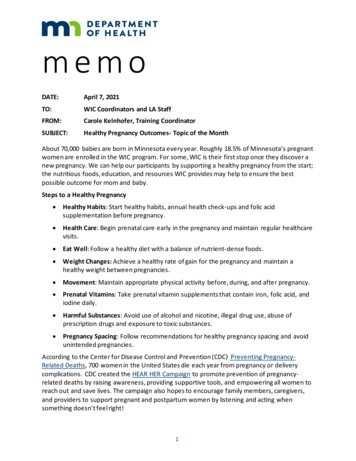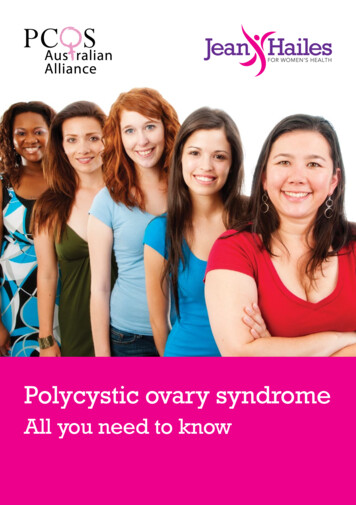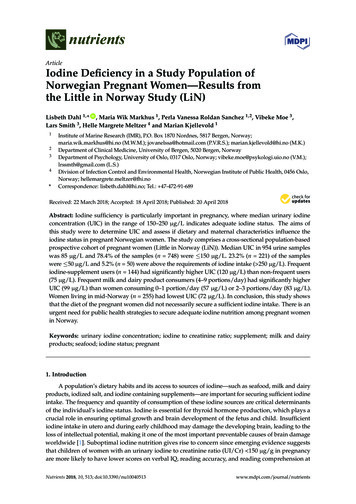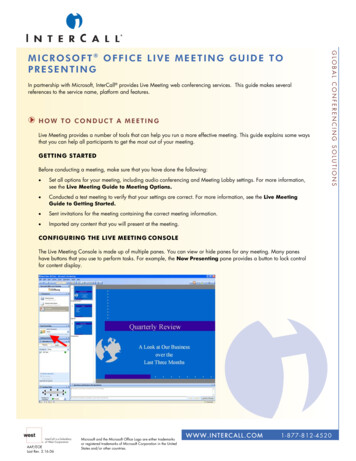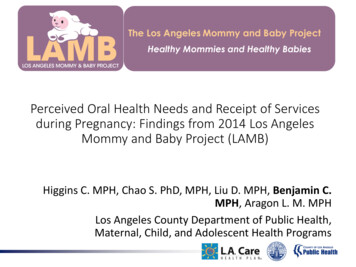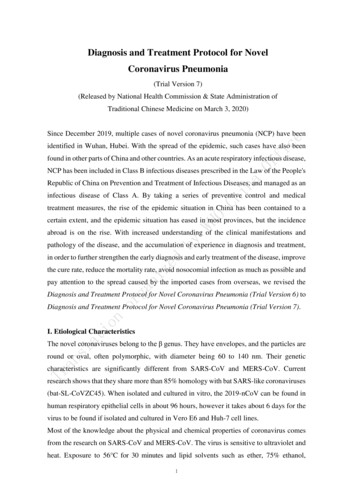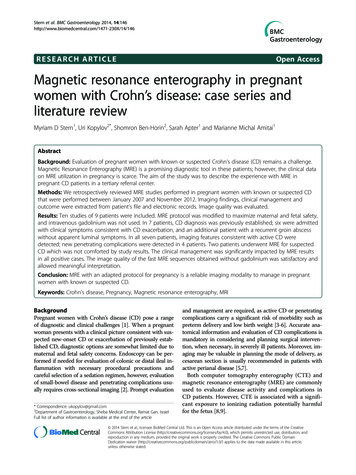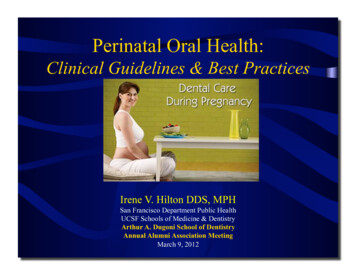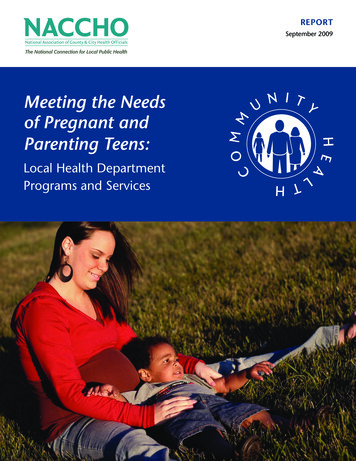
Transcription
REPORTSeptember 2009Meeting the Needsof Pregnant andParenting Teens:Local Health DepartmentPrograms and Services
Meeting the Needs of Pregnant andParenting Teens: Local Health DepartmentPrograms and ServicesTable of ContentsIntroductionBackground44-6Adolescent Family Life ProgramSan Mateo County Health SystemSanta Cruz County Health Department7-88-9The School and Community Health ServicesTeen Pregnancy Teen Parenting CaseManagement ProgramMontgomery County Department of Healthand Human Services10-11The Teen Parent ProgramSt. Paul-Ramsey County Department of Public Health12-14Challenges Faced by Programs TargetingPregnant and Parenting Teens15Recommendations16Conclusion17End Notes18Acknowledgements19
IntroductionPregnant and parenting teens have needs that are unique tothe developmental stages of adolescence, in addition to theneeds common to all pregnant women, mothers, and fathers.While teen pregnancy prevention advocates continue to placemuch needed attention on reducing teen pregnancy and teenbirth rates, programs and information about teenage pregnancyoften focus solely on prevention, with little emphasis placedon providing services for teens that are already pregnant and/or have become parents. In an effort to address this gap inpractice and knowledge, this report discusses the importance ofaddressing the special needs of pregnant and parenting teensin order to improve their health and life outcomes and thoseof their children. The four local health departments (LHDs)highlighted in this report are among a number of LHDs thatare implementing promising approaches to providing servicesfor pregnant and parenting teens and working to preventthe negative consequences often associated with teenagechildbearing and parenting.BackgroundThe Impact of teen ChildbearingTeenage pregnancy and birth rates in the U.S. have seensignificant declines since their most recent peak in 19911,but this trend reversed in 2006. The teenage pregnancy ratedeclined from 117 per 1,000 in 1991 to 72 per 1,000 in 2004.Similarly, the birth rate decreased by 30.5 percent from 61.8births per 1,000 females ages 15-19 in 1991 to 40.4 birthsper 1,000 in 2005, the lowest rate in six decades. However,preliminary data from the Centers for Disease Control andPrevention (CDC) on births in 2006 indicate that the overallbirth rate for teenage girls rose 3 percent to 41.9 births per1,000 females ages 15-19, the first increase in the teenage birthrate since 1991, suggesting that effective efforts to reduce theoccurrence of teen pregnancy continue to be needed.2Teenage childbearing carries large public costs, due to themedical and social complications that often accompany teenageparenthood. Recent research shows that teen childbearingcosts local, state, and federal taxpayers over 9 billion dollarsannually. This estimate includes various public sector costs suchas healthcare, child welfare, incarceration, and lost revenuebecause children of teen mothers pay lower taxes over theiradult lifetimes.3 In 2004, taxpayers saved an estimated 6.7billion dollars from the decline in the U.S. teen birth rate,discussed above. Although many pregnancy preventionprograms have not conducted formal cost-benefits analyses,these estimates are suggestive of the potential to generatetangible cost-savings through comprehensive, effective teenagepregnancy prevention programs.However, while there is a definite need for effective efforts thatfocus on preventing teen pregnancy in order to halt the recentincrease in the teen birth rate, we can not ignore the fact thatteens are still becoming parents and that these teen parentsneed supportive programs and services in order to reduce therisks for teen parents and their children.Research shows that teenage pregnancy is associated withmedical-related risks for the teen mother and infant anddevelopmental risks for the growing infant. When comparedto their older counterparts and their children, teen mothersand their infants are more likely to experience poor clinicaloutcomes such as pre-term delivery, anemia, low-birth weight,and infant mortality.6,7 Multiple studies also demonstrate thatchildren born to teenage mothers perform more poorly onvarious developmental assessments and academic achievementmeasures in areas of reading comprehension, mathematics, andvocabulary tests compared to children of adult mothers.8,9 Whilesome members of the general public have the misconceptionthat pregnancy-related complications and outcomes[4]Meeting the Needs of Pregnant and Parenting Teens: Local Health Department Programs and Services
experienced by teen mothers and their children are causedby age-related biological factors, research suggests otherwise.Clinical medical research presents strong evidence to suggestthat factors such as the delayed confirmation of pregnancy,delayed commencement of and inadequate prenatal care,lower compliance with medical advice, and maternal history ofadverse childhood experiences are stronger predictors of poorpregnancy outcomes in teenagers.3,4 Additionally, the differencesobserved in developmental measures between children of teenmothers and children of non-teen mothers in many researchstudies are often confounded by maternal family background.This suggests that maternal family and socioeconomicbackground, which are risk factors for early childbearing, arealso risk factors for poor childhood developmental outcomes.5,6This evidence supports the case of proponents for approachesaimed at pregnant and parenting teens by implying that thesocial and medical consequences of teen pregnancy can besignificantly reduced or eliminated with appropriate resourcesand programs.In addition to the aforementioned medical risks, teen parentsface a wide range of challenges on their way to becomingsuccessful, contributing adults and parents. Some of theseobstacles are related to interruptions in their education thatmay lead to challenges in obtaining a high school diploma anddecreasing their chances of attending college.4,10 Lack of highereducation limits a teen parent’s career options and increasestheir risk for living in poverty.4 Furthermore, teenage fathers aremore likely to face economic and employment challenges thanadult fathers, which negatively affects their ability to financiallysupport their children. In a number of cases, many teen fathersare absent and unable to financially support their children,increasing the difficulties that teenage mothers face withparenting.11Lastly, an important issue in need of attention is the highoccurrence of repeat pregnancies among teen parents. Despitethe fact that 22 to 30 percent of teen mothers under 18 havea second birth within 24 months of their first birth, there islittle attention and investment in programs and services to helppregnant and parenting teens avoid a subsequent pregnancy.7This highlights the need for greater pregnancy preventioninterventions targeting teenage mothers, such as educationabout and provision of contraception and comprehensive healthand social support.“ what we’re trying to do now is capture theteen fathers. They’re a lost group. They’re theones that have kind of fallen off and we’d liketo get them back into it.”—Montgomery County Department ofHealth and Human Servicesafter pregnancy, case management serves to connect teensto medical and social services present in the community.10Other case management programs are hospital-based, withhospital clinicians and social staff working with teens to ensurethey receive routine prenatal and maternal healthcare.11Case management and home visitation aspects of teenparenting programs also typically focus on improving personaldevelopment, strengthening parenting education, increasingschool attendance, and increasing access and usage of medicalcare services for mother and baby.Special Focus: Young FathersWhile many existing programs aimed at pregnant andparenting teens are tailored to teen mothers, public healthprofessionals interested in information about programs and bestpractices aimed at teen fathers often face difficulty finding thisinformation. Although years of research focusing on teen fathersindicates that teen fatherhood is associated with many of thesame social consequences associated with teen motherhood, theoverwhelming majority of programs that address teen parentingfocus solely on teen mothers.12 This occurs for a variety ofreasons, such as the following: A majority of fathers involved in teen pregnancies are olderCurrent Services and Programs for Pregnantand Parenting TeensPrograms and services aimed at pregnant and parenting teenmothers typically include a case management component.Generally provided to the teen by school staff or through acommunity program and/or regular home visits during andMeeting the Needs of Pregnant and Parenting Teens: Local Health Department Programs and Services [ 5]
than 20, resulting in fewer teen fathers than teen mothers Paternity is more difficult to determine than maternity,making teen fathers more difficult to reach Teen fathers may be reluctant to seek help or be identifiedas fathers for fear of reprisal16Although programs for teen fathers may be more difficult tofind as well as to conduct, examples of these programs doexist. There are a number of teen father programs across thecountry that focus on increasing male involvement in thefamily unit, transitioning teen fathers into adulthood, providingparenting education, developing life and employment skills, anddeveloping strategies to help improve communication with themother’s family.9, 13 ,16 Some programs use male program staffto recruit participants and serve as positive adult role models forteenage fathers.19 Consequently, programs aimed at both youngfathers and mothers improve the health and life outcomes oftheir children, who benefit from high quality involvement ofboth parents in their lives.9[6]Local Health Department RoleThe issues revolving around teenage pregnancy andparenting make it an important public health concern anda priority for LHDs, especially with the national teenagebirth rate increasing for the first time in more than adecade. Local health departments play an integral role inconnecting teenage mothers and fathers to the medicaland social services that they need, as well as addressingthe potential negative consequences that giving birth andbecoming a parent while still a teenager presents. Localhealth departments across the country have successfullyaddressed teenage pregnancy and parenting in theircommunities, demonstrating that teen parents can leadsuccessful lives with the help of suitable programs andservices. To provide examples of successful local levelprograms aimed at pregnant and parenting teens, theapproaches of four LHDs to teen pregnancy and parentingare described as follows.Meeting the Needs of Pregnant and Parenting Teens: Local Health Department Programs and Services
Adolescent Family Life Program:San Mateo County Health System andSanta Cruz County Health DepartmentProgram BackgroundSanta Cruz and San Mateo Counties, both located alongCalifornia’s Pacific coast, are among the most affluent areas ofthe country. However, staff from both LHDs note that areas ofsignificant poverty are present, many of them reflecting racialand ethnic disparities in income that exist locally. In additionto income disparities, both LHDs state that racial disparitiesbetween white and Hispanic/Latino birth rates exist.Currently, both the San Mateo County Health System (SMCHS)and the Santa Cruz County Health Department (SCCHD)implement the “California Adolescent Family Life Program”(AFLP), which grew out of a demonstration program providingservices to pregnant and parenting teens in the 1980s. Theprogram’s main goals are to do the following: Provide support for teen clients through case management Encourage the development of high quality relationshipswith and between teens and their families Encourage healthy lifestyle decisions Increase the utilization of healthcare resources Increase the delivery of healthy babies Encourage and increase school attendance Prevent unintentional pregnancies among teens“I think the strength of California’sAdolescent Family Life Program is thatthey’ve kept the goals broad. That hasenabled those of us on the local level toidentify who are we really serving andtailor our program accordingly.”—Santa Cruz County Health DepartmentThe broad nature of the state’s goals has enabled SCCHDand SMCHS to tailor the AFLP program in a way deemedappropriate to serve the specific needs of pregnant andparenting teens in their respective jurisdictions. In addition,many innovative components of the SMCHS AFLP have beendeveloped and implemented as demonstration projects througha long-term federal grant. Although home visitation is the majorcomponent of the AFLP in San Mateo and Santa Cruz, SMCHSand SCCHD have both incorporated additional componentsinto the program.Teen Parent Program: Santa CruzCounty Health DepartmentProgram ParticipantsIn Santa Cruz, the AFLP is locally known as the “Teen ParentProgram.” The program primarily receives referrals fromschools, hospitals, and clinics, and is open to pregnant andparenting females 18 years old and younger and teen fathersyounger than 21. The program’s clients are primarily females.However, teen fathers can enroll in the program if they havedaily responsibilities for the child and are able to meet with thenurse according to AFLP standards.Key Program ComponentsAfter acceptance into the program, teens are each assignedto public health nurses employed by SCCHD. Targetedinterventions are developed for teen clients based on structuredassessments conducted by the public health nurses. Theseinterventions focus on promoting the health of mother andchild. Home visits are enhanced by the addition of educationalmodules (developed by the program’s public health nurses)on topics such as fire safety, vitamin use, dental hygiene, andnutrition. During times of great program demand, for instanceat the start of a new school year, referrals to the program areprioritized by age (with younger teens taken into the programfirst) and risk factors, including a history of domestic violenceand lack of school attendance. Because most of the teenparents remain in the program for 12-15 months, some evenstaying for up to five years, the program has been able toprovide pregnant and parenting teens with caring, healthy,and substantial relationships with adults. SCCHD believes theserelationships are essential in improving life outcomes for teensand their children.SCCHD staff members working on the project have learned theimportance of building quality measures into the program andMeeting the Needs of Pregnant and Parenting Teens: Local Health Department Programs and Services [ 7]
“We believe they will succeed. Wealso know that a caring relationshipwith an adult is a key factor to thatsuccess, and for many of them wecan become that caring adult.”—Santa Cruz County Health Departmentmaintaining a framework that encourages continual learningand improvement. For state-level evaluation purposes,data for each client is collected at intake, after pregnancy,and every six months thereafter. For SCCHD’s evaluationpurposes, public health nurses collect specific outcomedata (such as infant immunizations, graduation rates, familyplanning choice, breastfeeding, repeat births, and seat beltand car seat use) when a client’s case is closed, using theaggregate data to identify areas of improvement to focus onfor the following year. For instance, educational modules onfire and home safety were developed and smoke alarms weredistributed to selected families after the program’s nursesrealized that the outcome data concerning hazards in thechild’s environment was poor throughout the year. By beingdirectly involved in the evaluation of the program, nursesview quality improvement as an integral component of theirwork and a way to achieve personal and programmatic goals.Community Partnerships and CollaborationsThe Teen Parent Program receives referrals from schools,hospitals, clinics, and family resource centers, but therelationship with these partners goes beyond a referralnetwork. As primary case managers for program participants,public health nurses collaborate with these partners to ensurethat services and care received by the teen are not duplicatedbut instead effectively coordinated. Together, SCHHD and itspartners work together to provide services to pregnant teens.Adolescent Family Life Program:San Mateo County Health SystemProgram ParticipantsIn terms of positively impacting the lives of pregnant andparenting teens, SMCHS’s AFLP places emphasis on not onlydecreasing the rate of repeat teenage pregnancies but also onstrengthening the education and mental health of programparticipants. The SMCHS’s AFLP targets female pregnant orparenting teens, ages 13 to 18, as well as their male partnersor young fathers up to the age of 27. A large portion of theprogram’s clients are females who are referred to the programduring their first trimester. However, parenting males andfemales can enroll in the program as long as they are withinthe target age range and can remain in the program until themother is 20 and the father is 27.Key Program ComponentsThrough the implementation of their version of the AFLP,SMCHS staff members have witnessed firsthand the successfuloutcomes of using public health nurses and communityhealth workers (both employed by SMCHS) to conduct homevisits, as their different strengths complement each other andaddress the range of health and social needs that are specificto pregnant and parenting teens. In addition to seeing clientsin the home, nurses and community health workers also meetclients in local schools and clinics. Visits primarily focus onhealth education, mental health screenings, and linking clientsto health, education, housing, and other necessary resourcesin the community. Public health nurses also provide prenatal,postpartum, and infant assessments in the home. While eachof the program’s clients receives the home visitation casemanagement component of the program, some clients areProgram’s ImpactSCCHD emphasizes the cultivation of a caring relationshipbetween each teen client and an adult. Through the TeenParent Program, staff members have realized the importanceof helping each teen believe in their personal ability to besuccessful. By promoting youth development and resiliency,staff members believe that pregnancy can serve as a catalystfor improvement.[8]Meeting the Needs of Pregnant and Parenting Teens: Local Health Department Programs and Services
referred to outside mental health services or social supportgroups, depending on need.In addition to including the core AFLP component of homevisitation, SMCHS’s AFLP also incorporates mental healthservices, social support and youth development groups,and occasional family-centered social activities into its workwith pregnant and parenting teens. The program’s mentalhealth component includes a variety of unique mentalhealth services which are primarily offered in the home bya Marriage and Family Therapist, such as individual and/ordyad therapy and art therapy. Additionally, the program hasthree social support and youth development groups that areconducted within the community, including a “Young Dads”group that provides social support and parenting classes foryoung fathers. Mental health services and support groups areaimed at decreasing depression, eliminating social isolation,and improving functioning and stability over time.SMCHS’s AFLP has had significant success in engaging youngfathers and involving them in the family unit. This successhas been attributed to the case manager assigned to youngfathers, who has been able to use his own experiences as ayoung father to conduct outreach and assist young fathersin identifying their needs. Through case management andsupport groups, SMCHS addresses the needs of youngfathers in the program, including the need for parentingeducation, educational/training resources, and legalinformation (e.g., child custody, child support, paternal rightsinformation).rates of children in the program (97 and 90 percent,respectively), low numbers of preterm and low birth weightinfants born to program participants, and significantpercentages of program clients who are enrolled in school.Lessons LearnedSCCHD and SMCHS have both learned various lessons fromimplementing the AFLP in their respective counties. Thefollowing are of utmost importance to SCCHD: Actively monitoring the funding and billing of services,while remaining flexible and open to many fundingsources Building quality measures into the program andmaintaining a mindset of continual learning andimprovement Nurturing relationships with community partnersSMCHS has learned the following: Home visitation models are successful in reducingbarriers to accessing health and other services forpregnant and parenting teens Mental health screenings and other services are vitalcomponents of its program Developing and maintaining relationships with asmany community partners as possible is integral inattaining program goalsCommunity Partnerships and CollaborationsNot only has SMCHS’s AFLP been successful in engagingyoung fathers, but it has also succeeded in buildingcollaborations with community partners. Through advocacyand collaborations with other organizations, San Mateohas been able to impact participants’ needs for education,mental health services, childcare, and legal advice. SMCHSoften works with county youth health centers, a collaborativegroup of youth services providers, prenatal providers, schooldistricts, and local legal aid societies, who are instrumental inproviding teen-specific legal information to participants. TheAFLP often serves as a referral source for these partners.Program’s ImpactBy removing barriers to positive health and health services,an issue faced by many pregnant and parenting teens, bothSCCHD and SMCHS have seen high childhood immunization“They always have various needs, including issueswith childcare, finances, jobs, mental health,education, legal concerns, health, support,custody, and restraining orders. The way thatwe’ve been able to make an impact with thoseneeds is primarily through the case managers,their public health nurses and community workers,and creating linkages to community resources.Really advocating for the clients and helping themnavigate the system is essential. ”— San Mateo County Health SystemMeeting the Needs of Pregnant and Parenting Teens: Local Health Department Programs and Services [ 9]
The School and Community HealthServices Teen Pregnancy TeenParenting Case Management Program:Montgomery County Department ofHealth and Human ServicesProgram BackgroundThe Montgomery County Department of Health andHuman Services (MCDHHS) serves the large, ethnically andsocioeconomically diverse population of Maryland’s MontgomeryCounty, located just outside of Washington, DC. To address thespecific needs of teen parents in the county, MCDHHS developedthe “Teen Pregnancy and Teen Parenting Case ManagementProgram,” a multifaceted intervention that grew out of thedepartment’s existing School Health Services Division in the early1980s. Since then, a partnership has developed between schooland Community Health Center (CHC) nurses to provide a widerange of services and support for pregnant and parenting teens,both inside and outside of the school setting. MCDHHS’s TeenPregnancy and Teen Parenting Case Management Program issupported by a combination of private, local, and state funding.Program ParticipantsThe Teen Pregnancy and Teen Parenting Case ManagementProgram is open to all pregnant and parenting teens, althoughmost teens enter the program during pregnancy. MCDHHS doesnot target any specific population; however, the department hasbegun to address the steady increase in Latino teen birth rates.Program staff are trained in conducting outreach to the county’s[10]Latino families and teens to ensure that the program’s messageis sensitive to the culture and values of this growing population.Key Program ComponentsThe Teen Pregnancy and Teen Parenting Case ManagementProgram’s main goals are to do the following: Ensure a birth weight of at least 5.5 pounds amongchildren born to teen clients Keep program participants in school Prevent repeat teen pregnancies among programparticipantsTo accomplish these goals, the program consists of twomain components which are home visitations conducted byCHC nurses employed by MCDHHS and school-based healtheducation carried out by MCDHHS’s school nurses. Together,school and CHC nurses located throughout the county workseamlessly within a case management framework.School nurses are often the program’s first point of contactwith students entering the program, and remain in closecontact with teen clients throughout the duration of theirinvolvement in the program. In addition to providing supportand educational services on an individual basis, school nursesalso facilitate parenting groups in high schools with at least fourpregnant or parenting students, on an at least bi-monthly (butoften once a week) basis during the school day. Although thegroups do not follow a set curriculum, they do have specificgoals such as improving self esteem, teaching students howto identify and express feelings, and providing education,information, and opportunities for discussion. By participatingin these support groups, pregnant and parenting studentsgain information on topics such as positive parenting, properprenatal care, contraceptives, graduation, and county resources.These groups also give participants the opportunity to meetand engage with other teen parents. Even though the parentinggroups are primarily composed of females, teen fathers whoare attending high school are always invited to participate inthe group when indentified by school nurses. Teen fathers arealso referred to the county’s “Responsible Father’s Program,”which uses mentoring and support services to encourage youngfathers to be positive role models in their children’s lives.In addition to support received within the school setting, teenmothers also receive support from an assigned CHC nurse, whomay also case manage parenting students who did not return toschool. CHC nurses conduct home visits and connect studentsMeeting the Needs of Pregnant and Parenting Teens: Local Health Department Programs and Services
to necessary resources, such as medical assistance and maternityprograms. Home visits take place a minimum of three timeswhile the client is pregnant and every other month while theclient is parenting. Together, school and CHC nurses providethe necessary support to ensure healthy births while keepingteens in school and moving them closer to their primary goal ofhigh school graduation.Because the program’s school nurses come from differenteducational and professional backgrounds, MCDHHS hasrecently placed emphasis on professional development andstandardization of the case management process. Schoolnurses are not only trained on general case managementbut also on teaching methods that take into account theunique neurological and social development characteristicsof adolescents. This enhanced training has significantlystrengthened the skills of the nurses in regards to educatingstudents and facilitating support groups.Community Partnerships and CollaborationsMCDHHS supports the county’s Interagency Coalition onAdolescent Pregnancy (ICAP) by providing financial andpersonnel support and other resources for the coalition. Thecommunity coalition, with representation from public andprivate programs and community organizations, has beeninstrumental in advocating on behalf of the county for increasedfunding for programs aimed at pregnant and parenting teens.ICAP also works to educate the county’s political leaders aboutthe issues concerning teenage pregnancy and parenting.MCDHHS collaborates with ICAP to sponsor an annual teenparent conference that provides educational information andother resources to pregnant and parenting teenage mothersand fathers in Montgomery County.“We want to see them graduate. We knowthat education is the key to not only theirfuture, but their child’s future. Our primaryfocus is to keep them in school.”— Montgomery County Department of Healthand Human ServicesLessons LearnedAfter implementing the program for a number of years,MCDHHS has learned many lessons, including the following: Education is of utmost importance, not only for thestudents but also for the students’ families and thecommunity at large Encouraging parenting teens to stay in school is justas essential as building a community awareness of thesignificance of education for the entire community An emphasis on data collection and data analysis isnecessary in understanding shifting demographics andchanges in the needs of the population served, as wellas how this impacts service delivery modelsProgram’s ImpactThe program has been successful in keeping repeat pregnanciesamong their clients down to 1.2 percent over the pastfour years. Furthermore, program staff note that the casemanagement component of the Teen Pregnancy Teen ParentingCase Management Program continues to have a substantialimpact on addressing the need for social support and advocacyexpressed by teen clients. MCDHHS believes that pregnantand parenting teens are often stigmatized and left without avoice. School nurses within the program serve as advocates forthe teens and the program provides teens with multifacetedsupport that is necessary to attain healthy life outcomes.Meeting the Needs of Pregnant and Parenting Teens: Local Health Department Programs and Services [ 11]
The Teen Parent Program:St. Paul-Ramsey County Departmentof Public HealthKey Program ComponentsThe Teen Parent Program’s main objectives for pregnant andparenting teens are to do the following: Promote healthy te
San Mateo County Health System 7-8 Santa Cruz County Health Department 8-9 . The School and Community Health Services Teen Pregnancy Teen Parenting Case . Management Program. Montgomery County Department of Health . and Human Services . 10-11. The Teen Parent Program . St. Paul-Ramsey County Department of Public Health . 12-14



